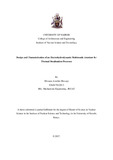| dc.description.abstract | Water is one of the three basic necessities (Air, water and food) of life on earth. Access to adequate quantities of safe andfresh water for drinking, domestic, commercial, agricultural and industrial application is vital to human, health and ecosystem well-being as well as to achieving sustainable economic development.Worldwide water scarcity, climate change, bad management of available water sources, population and industrial growth are pressing the world to come up with innovative ways of sourcing for clean drinking water. Seawater desalination is a promising technology since theabundance of seawater makes it one of the favourable sources for desalination. Among many other desalination processes, multi effect distillation is known for its robustness and high production; however it still delivers a recovery ratio (total fresh water volume per total inlet volume) of only 10%. There is therefore need to increase its efficiency. The objective of this research work was to design and characterise a multinozzle atomizer which uses electrohydrodynamic atomization, also known as electrospray, to create small sized electrically charged droplets to improve the efficiency of thermal desalination processes. This researchwork involved the study of the attraction of droplets to the tube, designing of the multinozzle atomizer prototype, computational modelling to check the process parameters, simulating the complete design and characterising the working conditions of the device. Bench scale experiments were carried out to investigate the behaviour of the electrohydrodynamic multinozzle atomizer and the properties of the droplets. Additionally, a second prototype was designed and studied to eliminate the limitations experienced by the first one.The design and characterisation of the electrohydrodynamic multinozzle atomizer was done. It was observed that there was reduction in droplet diameter and the droplets of the outermost nozzles had a wider dispersion compared to the inner nozzles with increase in voltage. The results of the bench scale experiments matched with both the particle trajectories and electric field modelling. The elemental concentration of the seawaterdid not change significantly with the application of high voltage during the electrospray process. | |



